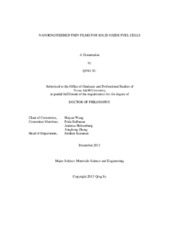| dc.contributor.advisor | Wang, Haiyan | |
| dc.creator | Su, Qing | |
| dc.date.accessioned | 2014-05-13T17:20:49Z | |
| dc.date.available | 2015-12-01T06:31:14Z | |
| dc.date.created | 2013-12 | |
| dc.date.issued | 2013-11-21 | |
| dc.date.submitted | December 2013 | |
| dc.identifier.uri | https://hdl.handle.net/1969.1/151728 | |
| dc.description.abstract | Solid oxide fuel cells (SOFCs) are very attractive as energy generation devices because of their high energy efficiency, flexible fuel selections and clean energy conversion. To avoid cell cracking and formation of non-conducting compounds at electrolyte/electrode interfaces issues caused by high operating temperatures (~1000 ºC for conventional SOFCs), intermediate temperature SOFCs (ITSOFCs) in the range of 500-700 ºC have attracted extensive research interests. However, the polarization loss of cathode and ohmic loss of electrolyte significantly increases under reduced temperatures which lead to decreased cell performance and power output. To address the above issues, the efforts in this work are focused on engineering microstructure of cathode, electrolyte and their interface to achieve high performance.
First, a bi-layer method has been developed to prepare La0.5Sr0.5CoO3 (LSCO) cathode by combining a pulsed laser deposition (PLD) technique and a screen printing method. It provides a cost-effective approach to fabricate thick and high quality cathode films and the method could also be applied to many other cathode systems. Second, detailed PLD interlayer thickness effect is investigated. The mechanical and electrochemical properties of those hybrid cathodes are examined and correlated with the microstructure of the cells with different interlayer thicknesses. Third, partial oxygen pressure AC impedance study has been carried on those bi-layer cathodes with different interlayer thicknesses. The guidelines for designing high-performance bi-layer cathodes with optimum performance and low cost are proposed. Fourth, the design of a La0.8Sr0.2MnO3-δ/Zr0.92Y0.08O2 thin interlayer with a vertically-aligned nanocomposite (VAN) structure between the electrolyte and oxygen electrode is demonstrated for solid oxide reversible fuel cells. The VAN structure significantly improves the overall cell performance and also acts as a transition layer that improves adhesion and relieves both thermal stress and lattice strain. Fifth, Two-phase (Ce0.9Gd0.1O1.95)0.5/(Zr0.92Y0.08O1.96)0.5 nanocomposite thin films with vertically aligned structure are grown as the electrolyte for thin film solid oxide fuel cells (TFSOFCs). More than 50% increase in overall power density is achieved compared with that of the cells without VAN electrolyte. | en |
| dc.format.mimetype | application/pdf | |
| dc.language.iso | en | |
| dc.subject | Solid oxide fuel cell | en |
| dc.subject | cathode | en |
| dc.subject | electrolyte | en |
| dc.subject | microstructure | en |
| dc.subject | interface | en |
| dc.subject | pulsed laser deposition | en |
| dc.title | Nanoengineered Thin Films for Solid Oxide Fuel Cells | en |
| dc.type | Thesis | en |
| thesis.degree.department | Materials Science and Engineering | en |
| thesis.degree.discipline | Materials Science and Engineering | en |
| thesis.degree.grantor | Texas A & M University | en |
| thesis.degree.name | Doctor of Philosophy | en |
| thesis.degree.level | Doctoral | en |
| dc.contributor.committeeMember | Balbuena, Perla | |
| dc.contributor.committeeMember | Holzenburg, Andreas | |
| dc.contributor.committeeMember | Zhang, Xinghang | |
| dc.type.material | text | en |
| dc.date.updated | 2014-05-13T17:20:49Z | |
| local.embargo.terms | 2015-12-01 | |


